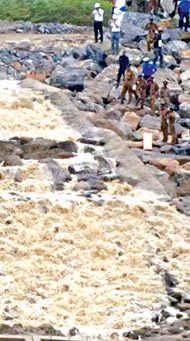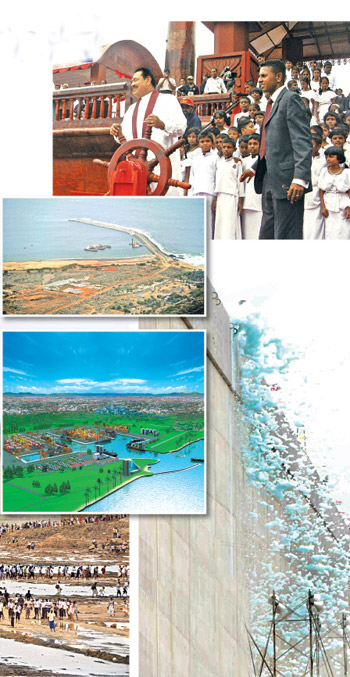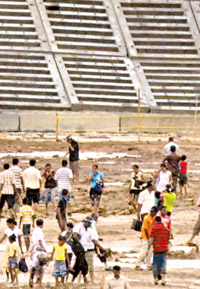|
Hambantota Inland Harbour:
A unique
man-made port
  The
foaming blue waters of the mighty Indian Ocean that kiss the golden
sandy beaches of our motherland perpetually suddenly began to flow
inland into Hambantota on August 15. But, no one ran away in fear unlike
on December 26, 2004, when the very same waters flowed inland, bringing
a wave of death and destruction with it. The
foaming blue waters of the mighty Indian Ocean that kiss the golden
sandy beaches of our motherland perpetually suddenly began to flow
inland into Hambantota on August 15. But, no one ran away in fear unlike
on December 26, 2004, when the very same waters flowed inland, bringing
a wave of death and destruction with it.
It was different on this day because the sea water that flowed
inland, only ushered in prosperity; not disaster. In fact, thousands of
people thronged to Hambantota, where the new harbour was being built, to
witness the historic Karadiyawara Mangallaya, or the ceremonial filling
of the harbour basin with sea water. This historic event took place at
the auspicious time of 9.58 am under the patronage of President Mahinda
Rajapaksa. The harbour basin which is 600 metres in diameter is
presently being filled with sea water at the rate of one metre a day. It
is expected to fill to capacity in three weeks time.
Why is the Hambantota harbour or port so special when there are two
significant harbours - the Colombo International harbour and the natural
harbour at Trincomalee, in the country already? It is because the
harbour under construction at Hambantota is said to be the largest
international inland harbour in the South East region, extending over
thousands of acres of land, once completed.
The project which is estimated to cost about 1.5 billion US dollars
is being carried out in phases. The foundation stone for the first phase
was laid way back in 2007 (October 30) and the construction work, done
with Chinese and local expertise began in January 2008. It is expected
to be completed by November this year. More than 85 per cent of the
funding and technical expertise is provided by the Chinese government
for this project, which is the first of its kind.
 The
Sri Lanka Ports Authority (SLPA) says that initially the Hambantota port
will function as a Service and Industrial Port and gradually be
developed into a Transhipment Port. Under the first phase, two berths to
handle cargo and fuel will be constructed. A sum of US dollars 300
million or more will be spent to carry out all the work under the first
phase and another US dollars 800 million for the second and third
phases. The port is expected to be completed by 2014.As Sri Lanka is
geographically placed between the straits of Malacca and the Suez Canal
and the Hambantota Port lies 10 nautical miles off the world's busiest
east-west shipping route, where over 36,000 ships including about 4,500
oil tankers pass by.The Sri Lanka Ports Authority says that once it is
completed, it would be capable of berthing between 35-40 ships at any
given time as it is the biggest inland port constructed in this 21st
century. It is initially expected to service around 2,500 of the 70,000
or more cargo ships that ply through the Colombo International Port. The
Sri Lanka Ports Authority (SLPA) says that initially the Hambantota port
will function as a Service and Industrial Port and gradually be
developed into a Transhipment Port. Under the first phase, two berths to
handle cargo and fuel will be constructed. A sum of US dollars 300
million or more will be spent to carry out all the work under the first
phase and another US dollars 800 million for the second and third
phases. The port is expected to be completed by 2014.As Sri Lanka is
geographically placed between the straits of Malacca and the Suez Canal
and the Hambantota Port lies 10 nautical miles off the world's busiest
east-west shipping route, where over 36,000 ships including about 4,500
oil tankers pass by.The Sri Lanka Ports Authority says that once it is
completed, it would be capable of berthing between 35-40 ships at any
given time as it is the biggest inland port constructed in this 21st
century. It is initially expected to service around 2,500 of the 70,000
or more cargo ships that ply through the Colombo International Port.
 This
unique port will comprise container terminals ,bunkering facilities, a
tank farm, dockyard and a 15 floor administrative complex. This
unique port will comprise container terminals ,bunkering facilities, a
tank farm, dockyard and a 15 floor administrative complex.
***********
Fast facts
* A port was known to be operational in Hambantota way back in 250
BCE with Arabs and Chinese merchants using it as part of the silk route.
* The mouth of the natural harbour is about 22 m in depth.
* Once completed, the breakwater will be 1.5 k.m. long.
* The depth of the basin will be about 17 m where as the depth of the
basin at the Colombo Port is 15.5 m.
* The turning circle is 600 m.
* In addition to the dam built to prevent flooding, a sea wall with
interlocking concrete blocks to protect the port from the high seas will
also be included in the project.
* The two general purpose berths built in the first phase comprise a
310 m bunkering berth and a 120 m craft berth.
* The oil tank farm will comprise eight tanks to store marine fuel,
three aviation fuel tanks and three Liquid Petroleum Gas (LPG) tanks
with a total capacity of 80,000 cubic metres.
* The Container Terminal and the dockyard are scheduled to be
constructed under the second and third phases.
* The services offered at the port includes bunkering crew change
facilities ship repair and ship building. |

